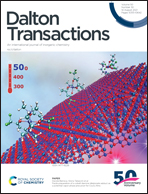HydG, the “dangler” iron, and catalytic production of free CO and CN−: implications for [FeFe]-hydrogenase maturation†
Abstract
The organometallic H-cluster of the [FeFe]-hydrogenase consists of a [4Fe–4S] cubane bridged via a cysteinyl thiolate to a 2Fe subcluster ([2Fe]H) containing CO, CN−, and dithiomethylamine (DTMA) ligands. The H-cluster is synthesized by three dedicated maturation proteins: the radical SAM enzymes HydE and HydG synthesize the non-protein ligands, while the GTPase HydF serves as a scaffold for assembly of [2Fe]H prior to its delivery to the [FeFe]-hydrogenase containing the [4Fe–4S] cubane. HydG uses L-tyrosine as a substrate, cleaving it to produce p-cresol as well as the CO and CN− ligands to the H-cluster, although there is some question as to whether these are formed as free diatomics or as part of a [Fe(CO)2(CN)] synthon. Here we show that Clostridium acetobutylicum (C.a.) HydG catalyzes formation of multiple equivalents of free CO at rates comparable to those for CN− formation. Free CN− is also formed in excess molar equivalents over protein. A g = 8.9 EPR signal is observed for C.a. HydG reconstituted to load the 5th “dangler” iron of the auxiliary [4Fe–4S][FeCys] cluster and is assigned to this “dangler-loaded” cluster state. Free CO and CN− formation and the degree of activation of [FeFe]-hydrogenase all occur regardless of dangler loading, but are increased 10–35% in the dangler-loaded HydG; this indicates the dangler iron is not essential to this process but may affect relevant catalysis. During HydG turnover in the presence of myoglobin, the g = 8.9 signal remains unchanged, indicating that a [Fe(CO)2(CN)(Cys)] synthon is not formed at the dangler iron. Mutation of the only protein ligand to the dangler iron, H272, to alanine nearly completely abolishes both free CO formation and hydrogenase activation, however results show this is not due solely to the loss of the dangler iron. In experiments with wild type and H272A HydG, and with different degrees of dangler loading, we observe a consistent correlation between free CO/CN− formation and hydrogenase activation. Taken in full, our results point to free CO/CN−, but not an [Fe(CO)2(CN)(Cys)] synthon, as essential species in hydrogenase maturation.
![Graphical abstract: HydG, the “dangler” iron, and catalytic production of free CO and CN−: implications for [FeFe]-hydrogenase maturation](/en/Image/Get?imageInfo.ImageType=GA&imageInfo.ImageIdentifier.ManuscriptID=D1DT01359A&imageInfo.ImageIdentifier.Year=2021)


 Please wait while we load your content...
Please wait while we load your content...
